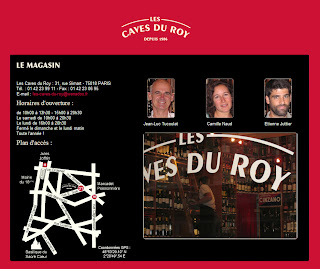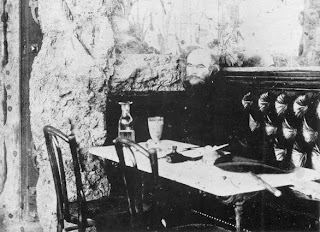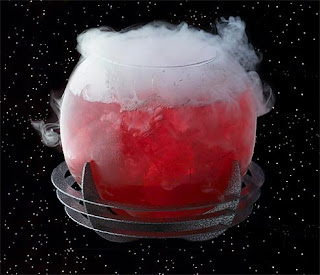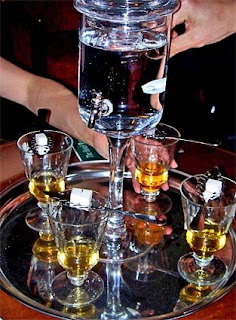









Proprietors introduce a new generation to its drinking rituals and mystique as myths of its hallucinogenic qualities are dispelled.
By Kevin Capp, Special to The Los Angeles Times01:26 PM PDT, October 15, 2008
Paris
I've come to the Paris Red Light District to kiss the Green Fairy full on the mouth, to sample the city's absinthe houses, where the notorious and powerful liquor is still cloaked in mystery.
Absinthe's supposed hallucinogenic properties once caused people to equate it with a sinister Tinker Bell, and it is this legacy that permeates Parisians' view of the drink. Many I spoke with still think it's illegal.
This is because absinthe harks back to a specific time and place that's suffused with legend and mystique. While the muse-like virtues of the green liqueur were extolled by Paris artists and writers during the late 19th and early 20th centuries, absinthe was ultimately banned in the United States (1912) and in France (1915), amid fears that it induced madness.
Four types of absinthe in Paris
It's recommended that you use about four measures of very cold water per measure of absinthe, but don't overdo it, because the more water you use, the more diluted the flavour. Although some manufacturers say you can drink theirs without sugar, the sweetness does help lessen absinthe's bitter bite. Here's how four types available in Paris taste following this basic formula:
• Versinthe (90 proof) -- Herbal kick makes it taste stronger
• Nouvelle-Orléans (136 proof) -- Floral component makes it gentle and savoury-sweet
• Mansinthe (132.2 proof) -- Piquant aroma hints at its strong flavour -- a pleasure
• Roquette 1797 (150 proof) -- Spicy yet mild -- the definition of "complex"
The primary culprit: thujone, the chemical found in wormwood, which was said to make imbibers hallucinate.
But absinthe is making a comeback in America and in Europe, thanks in part to studies that have shown that its dangers were exaggerated.
Today, with thujone content heavily regulated, absinthe is again being served around the world, including in California and, yes, Paris, where a history of bohemian behaviour seems perfectly suited to the anise-flavoured drink.
At three establishments here, I found the transcendent risk associated with absinthe, however exaggerated, is just as seductive as the complex ritual undertaken before consuming it.
In other words, one gets to feel like a bohemian without, theoretically, going bonkers.
I begin slowly at the lobby off the Royal Fromentin (11 Rue Fromentin, www.hotelroyalfromentin.com),
in the heart of Paris, where I drink a glass of versinthe, absinthe's weaker sister. The hotel's wood panels, ornate mirror and elaborate stone facade add to the jubilant Belle Époque vibe, as does the intricate glass fountain sitting on my table.
The Hotel Royal Fromentin has revived the myth of absinthe in a book written by Marie-Claude Delahaye, author of numerous works about absinthe and founder of the Musée de l'Absinthe in Auvers-sur-Oise. Let your imagination wander as you sip a glass of absinthe in the mythical bar of the former Don Juan Cabaret. Discover the authentic absinthe ritual in the very heart of this “quartier” of Paris, just as Van Gogh, Toulouse Lautrec, Baudelaire and so many others did before you. Here are some excepts from this book now available at the hotel.
Discover our « quartier » the way it was during the exciting “Belle Epoque” at the end of the 19th century. In the heart of Paris , in a neighbourhood steeped in history, the Hotel Royal Fromentin is the ideal spot to step back in time and discover absinthe. It was indeed a tradition in this area of Paris where the Belle Epoque poets and artists gathered, leaving a rich artistic legacy. At the junction of the famous “quartiers” of New Athens, Saint Georges and Montmartre , the rue Fromentin witnessed artists, poets, writers and performers on their way to the numerous cafés and cabarets in the area. And absinthe, the fashionable drink at the time, was served everywhere.
Often called the “Green Fairy” or “ the Muse”, the inspiration of many an artist, absinthe vapours floated in the air, their heady anise perfume escaping out on to the “Grands Boulevards” where cafés flourished and the atmosphere was carefree. From one café to the next, noisy groups of revellers made their way, sustained by numerous libations. The lobby of the hotel, formerly the Don Juan cabaret, has preserved all the charm of its origins with its wooden beams and painted wood panelling, its two great chimneys and its caryatids. Settle comfortably into one of the armchairs, in the heart of this “quartier” where so many famous artists once lived. Let your imagination wander down its streets where the fragrance of absinthe seems to magically linger yet.
Even though versinthe pales compared with genuine absinthe, you still prepare it the same way: by placing a measure of the liqueur in a thick, wide-mouthed glass, resting a slotted silver spoon holding a sugar cube across the glass, and then slowly letting icy water drip from the fountain's spigot onto the sugar until it melts away. This dilutes absinthe's bitterness and awakens its herbs and essential oils.
At the wine and spirits shop Les Caves du Roy (31 Rue Simart, www.cavesduroy.fr) you can learn all about absinthe from English-speaking absinthe connoisseur Camille Naud and select from about 30 types.
You also can purchase absinthe accoutrements, such as the spoons, specialty glasses and even fountains. Naud shows me a range of absinthes, from a bottle of Roquette 1797, which is based on a pre-ban recipe that's said to retain the flavour of the original.
The bottles run from $35 to $200. Naud recommends the Nouvelle-Orléans, made by a New Orleans native named T. A. Breaux that she says is her favourite because of its aromatic complexity. The bottle plus a 7-euro spoon (about $9.50) brings my total to around $54.
It's not until I belly up to the bar at the Cantada II (13 Rue Moret; www.cantada.net) that I have the closest thing to a true absinthe experience as you're likely to get in 21st century Paris. The atmosphere is a surrealist's paradise -- or, rather, paradise lost. Death metal gnashes its teeth over the speakers; the walls are blood-red and tiled with paintings of hell spawns; a wooden coffin stands upright behind the bar; and even the absinthe silver water fountains lining the bar suggest a faint evil.
It's creepy, sure, but once you get to know bartender Eddy and owner Mickey, whatever willies the atmosphere gives you dissipate like a sugar cube under cold water. I sample from the 25 absinthes on the menu, including a $7 glass of Mansinthe, from a recipe by rocker Marilyn Manson, and the Roquette 1797 ($13), a selection that elicits a "wow" from Eddy.
After the water and sugar do their thing in the 1797, I remove the spoon and swirl the mixture around, looking for what Naud labelled the "trouble" in the absinthe. I see what she means: still and sublime before the introduction of the two ingredients, the 1797's faint green now swims with an oily flare. In full defiance of the demons howling around me, the fairy flutters her wings and carries me heavenward.
"A journey of a thousand miles must begin with a single step." -- Lao Tzu
Copyright © Demetrios the Traveler

No comments:
Post a Comment